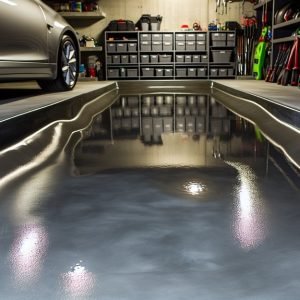Last Updated on October 30, 2025 by teamobn
Are you looking for ways to reduce your carbon footprint and increase your sustainability? Luckily, homeowners can start making a difference right in their yards. Sustainable landscaping is all the rage, and it isn’t hard to see why.
It helps promote water conservation, biodiversity, and eco-friendliness while maintaining an aesthetically pleasing outdoor environment. Below, we cover how you can create your own sustainable oasis.
Contents
Current Trends in Sustainable Landscaping
Sustainable landscaping has become the number one outdoor home improvement trend in 2024 because it promotes environmentally friendly practices.
It involves creating and maintaining outdoor spaces that conserve water, minimize environmental impact, and support ecological biodiversity. Here are some of the top current trends:
- Eco Lawns are made from native grasses, clover, and artificial or drought-resistant materials. These lawns are more sustainable and environmentally friendly because they require less maintenance, fertilizers, pesticides, and water to grow.
- Smart Landscape Technology includes systems and devices that help conserve water and energy through efficient use.
- Rainwater Harvesting is a process that collects and stores rainwater that is later used to irrigate lawns and gardens. It can help reduce water usage and costs, making it a staple in sustainable landscaping trends. Note that this practice is restricted in some areas.
- Automated Irrigation Systems deliver water more efficiently, helping to reduce water usage, evaporation, and runoff.
Planning Your Sustainable Landscape
On average, installing a sustainable landscape costs around $5,000 to $20,000. Here’s a breakdown of the costs:Components Average Cost Design $50 to $200 per hour Soil preparation and improvement $15 to $30 per test; $30 to $70 per cubic yard Plant selection and planting $3 to $15 per plant; $25 to $50 per hour Hardscaping $5 to $20 per square foot Maintenance $50 to $100 per hour
Of course, many of the costs associated with labor can be reduced if you do it yourself. If you have a green thumb, you can take on soil preparation and planting. However, for more specialty services like irrigation system installation, it is best to hire a landscaping contractor.
Specialty services from contractors are going to cost you, though. Luckily, many contractors now offer landscaping financing options that make it easier for homeowners to afford services.
Rather than paying for services in full upfront, you can apply for financing for a sustainable landscape. If you’re approved, you can pay in budget-friendly installments while the contractor starts the project immediately.
Choosing Sustainable Plants
Creating a sustainable oasis largely depends on the types of plants you choose to incorporate into your landscape. When deciding on which sustainable plants to add, consider the following factors:
Climate Compatibility
The U.S. is generally divided into nine climate zones. Depending on your region’s climate, some plants will be more tolerant and suitable for a sustainable landscape. Here are the regions and ideal plants:
- Tropical climates are warm and humid year-round. Choose heat and humid-tolerant plants with large leaves to capture sunlight and endure heavy rain.
- Arid and desert climates are hot and dry with little rainfall. Choose drought-tolerant plants that are slow-growing.
- Semi-arid climates have low rainfall but aren’t as hot and dry as arid or desert regions. Choose drought-tolerant plants that can withstand dry spells.
- Mediterranean climates have mild, wet winters and hot, dry summers. Choose drought-resistant plants that are acclimated to rocky or sandy soil.
- Humid subtropical climates have hot, humid summers and mild winters. Choose heat-tolerant and moisture-loving plants with dense leaves to capture moisture from the air.
- Humid continental climates have four seasons, with hot summers and cold winters. Choose frost-tolerant plants that can also withstand hot summers.
- Marine climates have mild temperatures all year with regular rain. Choose moisture-tolerant plants that can handle frequent rainfall and more acidic soil.
- Mountain and highland climates are generally cooler, with regular rain at higher altitudes. Choose hardy and wind-resistant plants that can tolerate colder temperatures and wetter soil.
- Polar and alpine climates are extremely cold all year with short summers. Choose hardy plants that can withstand extreme frost and low nutrient availability.
You can check your climate zone using the United States Department of Agriculture (USDA) Plant Hardiness Zone Map. It is available on the USDA website; simply input your ZIP code.
Soil Type and Quality
Certain plants also grow better in particular types of soil. Here are the general types of soil and the plants that prefer them:
- Sandy soil has large, coarse particles that offer great drainage but little nutrients. It is ideal for coastal, desert, and arid climates.
- Clay soil has fine particles and is great for nutrient retention but offers poor drainage. It is ideal for humid subtropical and continental climates.
- Silty soil also has fine particles with a smooth texture. It is good for moisture retention but can cause drainage problems. It is ideal for temperate and humid continental climates.
- Loamy soil is a balanced mix of sand, silt, and clay. It offers good drainage and nutrients. It is ideal for humid continental and temperate climates.
- Peaty soil has a lot of organic matter, helping retain moisture and provide nutrients. It is ideal for marine and cooler climates.
- Chalky soil has a stony or rocky texture, which is best for plants that need good drainage. However, it is nutrient-poor. It is ideal for temperate and Mediterranean climates.
Water Availability
All plants need water to grow. However, some require more than others. To maintain a sustainable landscape, choose plants compatible with your region’s natural rainfall levels.
Here are native plant options that are suitable to different climates and water availability:
- Succulents, desert shrubs, and drought-tolerant perennials are ideal for regions with dry spells and very little rainfall. Examples include aloe, agave, mesquite, sagebrush, yucca, and desert marigold.
- Native grasses, drought-resistant perennials, and Mediterranean herbs are ideal for regions with low to moderate rainfall. Examples include buffalo grass, blue grama, lavender, rosemary, and thyme.
- Drought-tolerant trees, shrubs, and perennials are ideal for seasonal regions with dry summers and wet winters. Examples include olive, cork oak, manzanita, and sage.
- Moisture-loving trees, shrubs, and perennials are ideal for regions with high rainfall. Examples include magnolia, azalea, gardenia, and ferns.
- Deciduous trees, perennials, and shrubs are also ideal for regions with moderate to high rainfall and humidity. Examples include maple, birch, daylilies, and hydrangea.
- Moisture-tolerant trees, shrubs, and perennials are ideal for regions with high and consistent rainfall. Examples include Douglas fir, red cedar, rhododendron, and astibe.
- Alpine plants, moisture-tolerant tees, and perennials are ideal for cold regions with higher precipitation. Examples include alpine aster, spruce, fir, and lupine.
- Cool-hardy perennials, shrubs, and grasses are ideal for regions with frost and snowmelt. Examples include arctic poppy, arctic birch, and tundra grasses.
Sunlight Requirements
Finally, all plants will require sunlight to grow. However, some are more tolerant to limited light conditions compared to others. Here are some plant options to consider based on your region’s sunlight availability:
- Oaks, pines, fruit trees, lavender, cacti, sunflowers, succulents, rosemary, prairie grasses, and butterfly bushes are ideal for regions that receive six or more hours of direct sunlight.
- Dogwood, hosta, azalea, rhododendrons, astilbe, foxglove, and hydrangea are ideal for regions that receive three to six hours of direct sunlight.
- Ferns, hostas, ivy, sugar maple, American beech, yew, and hellebores are ideal for regions that receive less than three hours of direct sunlight.
Water Conservation Techniques
Unless you’re going the hardscaping route or installing a rock garden, even the most sustainable landscape will require watering. But you can still practice sustainability and water conservation with these techniques:
- Drip Irrigation Systems deliver water directly to the roots, minimizing water loss due to evaporation and runoff. This process significantly reduces the amount of water used, contributing to higher conservation and sustainability.
- Rainwater Harvesting was briefly covered in the previous section. To start collecting rainwater, you can set up barrels or cisterns to gather larger volumes of water. As mentioned earlier, rainwater harvesting helps reduce reliance on municipal water, lowers bills, and more efficiently uses natural resources.
- Smart Irrigation Controllers use real-time data from weather forecasts and soil moisture levels to automatically adjust water schedules. This helps reduce overwatering, increases conservation, and lowers bills.
- Bioswales are a layout feature in your landscape design that collects and filters stormwater runoff. Bioswales can be redirected to garden beds or lawns, helping reduce municipal water usage. Like rainwater harvesting, bioswales make efficient use of natural resources.
Eco-Friendly Maintenance Practices
Sustainable landscaping is more than just reducing water usage. It also involves adopting eco-friendly maintenance practices to have positive long-term effects on the environment.
Here are some techniques you can adopt:
- Organic Fertilization involves using compost, manure, bone meal, and other organic matter to enrich soil health and provide nutrients. Using organic and natural fertilizers helps improve soil health, which allows plants to thrive and reduces reliance on synthetic fertilizers. Organic fertilization also eliminates runoff from chemicals, which reduces the impact on water quality.
- Integrated Pest Management (IPM) is a sustainable pest control practice that combines biological, mechanical, and organic methods. IPM aims to manage pests with little to no environmental impact. For example, you can introduce ladybugs as natural predators to pests. IPM reduces the reliance on pesticides, helping protect biodiversity and ecological balance.
- Natural Pest Deterrents are similar to IPM as they aim to control pests with minimal environmental impact. Examples of natural deterrents include garlic spray and neem oil, which help reduce reliance on synthetic pesticides. Natural pest deterrents also minimize water contamination and harm to non-target organisms.
- Companion Planting involves growing symbiotic plants close to each other to enhance growth and naturally repel pests. Companion planting helps reduce reliance on chemicals for pest control and supports biodiversity. For example, you can plant marigolds and basil near tomatoes to help deter nematodes and aphids.
Sustainable Lawn Alternatives
If you don’t have much of a green thumb or prefer a very low-maintenance lawn, there are suitable sustainable alternatives you can explore. Here are some popular options:
- Ground Cover can be made up of low-growing plants that spread quickly and require little water. Examples include creeping thyme, clover, and periwinkle.
- Native Grasses are already adapted to the local climate and soil conditions. They also require minimal water and maintenance. Examples include buffalo grass, blue grama, and little bluestem.
- Wildflower Gardens are a mixture of native low-maintenance flowers. They can attract pollinators that support a biodiverse landscape. Examples include California poppy, lupine, and black-eyed Susan.
- Artificial Turf is made of hardy artificial materials. It requires no watering, fertilizing, or maintenance. Examples include polyethylene, nylon, and polypropylene.
- Hardscaping makes use of stones, concrete, and wood to create sustainable and beautiful outdoor spaces. It eliminates water usage while still maintaining a functional and aesthetically pleasing landscape. Examples include patios, stone pathways, and gravel gardens.
Conclusion
An outdoor area is a great way to unwind and enjoy the beauty of nature. Sustainable landscapes let you relax while also helping the environment. With this guide, you can pick up a shovel or contact a local professional to create the sustainable yard of your dreams.
FAQ
How Can I Incorporate Sustainable Practices Into An Existing Traditional Landscape without Completely Overhauling It?
If you don’t have the funds for a full overhaul, you can make gradual, sustainable changes to your landscape. For example, you can replace a portion of your lawn, add rainwater collection barrels, or introduce a small native plant garden.
Are There Sustainable Landscaping Grants or Incentives Available for Homeowners?
Yes, your local government, water district, or environmental agency likely offers grants and incentives that can make sustainable landscaping more affordable. For instance, you could receive rebates for installing smart irrigation systems or starting to harvest rainwater.
How Can I Attract Pollinators to My Sustainable Landscape?
Include flowering plants that bloom during different seasons to attract bees, hummingbirds, and butterflies. Add birdbaths and habitat features to attract more pollinators.






